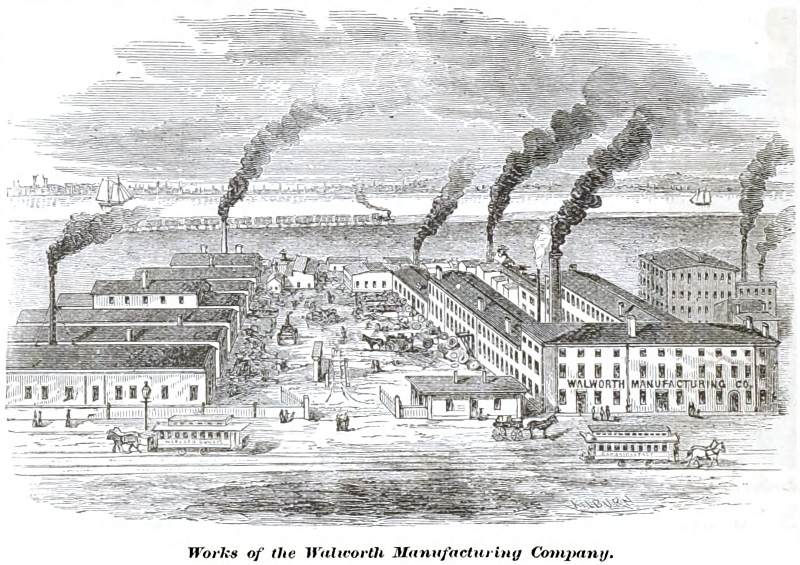
1874
This partnership of James J. Walworth, Joseph Nason, and Charles M. Guild traces its roots back to 1842 when it began in Boston as Walworth & Nason; the firm of Walworth, Nason & Guild seems to have been a sort of New York spinoff. It appears that in 1848, they briefly manufactured and sold a lathe. This firm was much better known for their steam heating and gas lighting products.
Nason had left Boston for New York in 1852, and we assume that he was running Walworth, Nason & Guild. It appears there was some bad blood between Messrs. Nason and Guild, and Walworth, Nason & Guild was dissolved in 1853. Nason continued on as Joseph Nason & Co. The Boston firm of Walworth & Nason became J. J. Walworth & Co., which was reorganized in 1872 as Walworth Manufacturing Co. They manufactured a line of combination and pipe vises as well as the famous Stillson wrench.
Subsequent histories of Walworth & Nason, J. J. Walworth & Co., and Joseph Nason & Co. rarely mention Guild or the firm in which he was partner, and information on them is difficult to come by.
Information Sources
- A page of the Nova Scotia Antique Engine & Tractor Association gives a history of the Walworth Manufacturing Company. It says that the business "began in 1842 as Walworth and Nason under the operation of James Jones Walworth in partnership with his brother-in-law, Joseph Nason. The 2 men started out in New York and soon moved to Boston where they were classified as engineers and iron tube manufacturers primarily in the heating industry... Around 1847, J. J. Walworth's younger brother, Caleb Clark Walworth joined the company... in 1852, the partnership of Walworth and Nason was dissolved mainly because Joseph Nason was unable to stand the severe winters of Boston. He moved to New York and set up a similar business which he carried on successfully (as Joseph Nason & Co.) until his death... Following the dissolution of the Walworth & Nason partnership, J. J. and C. C. Walworth moved the company on to remarkable success under a new name, J. J. Walworth & Co., a name which stayed with the company for many years... After the (Civil) War, Dan Stillson went to the Walworth Company to ask for a job... About 2 years later, in 1869, Stillson whittled a pattern out of wood that represented a new type of wrench that was superior in design to anything else being used at that time..." The Stillson wrench was patented and became a mainstay product for the company for decades. The web page concludes, "All information was taken from a copy of a book sent to me by the Walworth Company A History of 100 Years of Valve Manufacturing - The story of the Walworth Company, Inc, oldest manufacturer of Valve and Fittings in the United States -1942".
- America's Successful Men of Affairs. An Encyclopedia of Contemporaneous Biography, in a biographical sketch of one Felix Campbells, says, "In 1848, he entered the factory of Walworth, Nason & Guild, No. 79 John street, New York city, to learn steam heating and engineering. Having mastered the art, he was made foreman at the age of twenty-two, and held this position for ten years, leaving only to go into business for himself. The old firm having removed to other quarters, he hired the old place on John street and established himself in business..."
- Doggett's New-York City directory, for 1848-49 provides us with the initials of the mystery partner: "C. M. Guild". With that information we found an 1851 patent for a steam trap co-granted to one Charles M. Guild of New York.
- Seventh Annual Report of the American Institute, March 1849, including the results of the 1848 Fair: "Walworth, Nason & Build, 79 John-street, for the best small size hand lathe. Diploma." It is most likely that this lathe was primarily for working metal. We have not found any patents or ads that might shed light on this, nor can we confirm that the lathe was ever actually manufactured and sold.
- Poor Richard's Almanac for 1850 has an ad for "Walworth, Nason, & Guild, Welded Wrought Iron Pipe, and fixtures for steam, gas, water, &c. No. 79, John-street, New-York. Gas Apparatus erected for lighting Mills, Churches, Hotels, and other public buildings, on an improved plan. Steam and Hot-water apparatus constructed for Warming and Ventilating Buildings. Steam Boilers, Boiler Flues, &c., always on hand."
- From the 1854-01-27 issue of the New York Times, in a listing of Superior Court activity:
Down against Walworth.—This suit was brought against Messr. Walworth, Nason and Guild, formerly in partnership, to recover from them the price of certain gas meters, said to have been sold to them by plaintiff. Only the defendant, Nason, resisted the recovery; and his defense was placed upon the ground that the sale was made to Guild, and not to the firm; and that the plaintiff knew, before he sold the meters to Guild, that the partnership had been dissolved.
- James J. Walworth Papers, 1828-1912
- Archived article by Todd Werts (ToolArchives.com) Walworth Manufacturing Co.